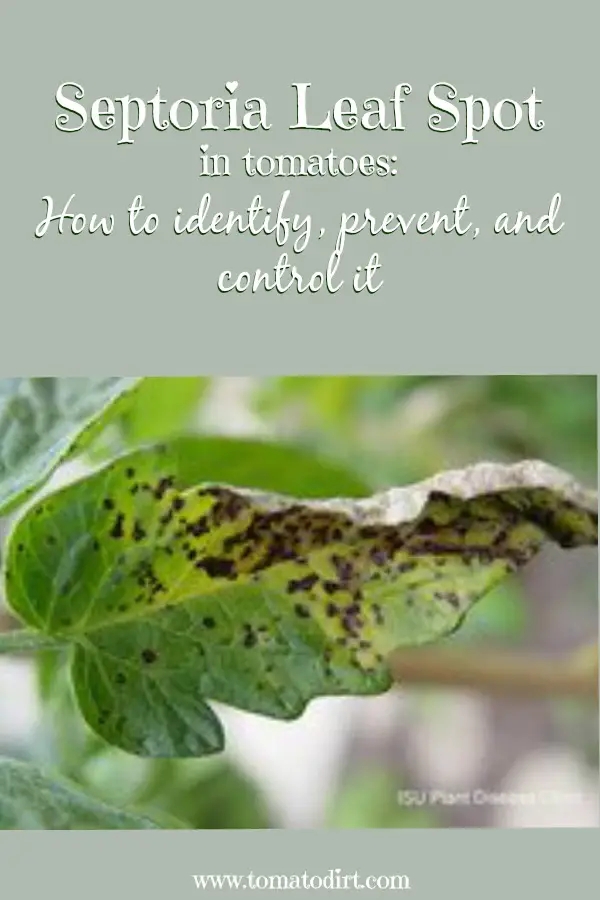Tomato Problems: How to Identify and Treat Septoria Leaf Spot
Since 2010, Tomato Dirt has garnered 4.8+ million views, making it the web’s leading online source for growing tomatoes in the home garden. Award-winning writer and Tomato Dirt owner Kathy Widenhouse has helped thousands of home gardeners grow healthier tomatoes. Be one of them when you get Tomato Dirt’s Growing Guide here.
Updated 6.16.24
Septoria leaf spot, caused by the fungus Septoria lycopersici, is sometimes mistaken for early blight in tomatoes – and vice versa. In fact, tomato plants can be infected with both at the same time.
What does Septoria leaf spot look like?
Fortunately, it’s not hard to distinguish between Septoria and early blight. Plus, they can be treated similarly.
Here's what to look for:
Lower leaves show symptoms first.
Round, yellow or water-soaked spots appear on the undersides of leaves. They quickly emerge on leaf tops and turn to black or brown with tiny black dots in the center.
Heavily infected leaves turn completely yellow, then brown, and fall.
Spotting works its way up the plant and can infect stems.
Septoria leaf spot does not display characteristic “target” or concentric spots seen in early blight.
Fruit is rarely infected.
When does Septoria leaf spot affect plants?
- It can attack at any point in the season
- It strikes frequently in early to mid-season
- It’s most common in humid weather
- It often affects tomato plants after a period of heavy rainfall
How do you control and treat leaf spot?
- The best control measure for tomato blight is prevention (see below).
- Remove and destroy infected leaves (be sure to wash your hands afterwards).
- Once blight is present and progresses, it becomes more resistant to biofungicide and fungicide. Treat it as soon as possible and on a schedule.
- Organic fungicides. Treat organically with copper spray, which you can purchase online, at the hardware store, or home improvement center. Follow label directions. You can apply until the leaves are dripping, once a week and after each rain. Or you can treat it a host of different ways with natural fungicides for tomatoes.
- Chemical fungicides. Some gardeners prefer chemical fungicides, the best of which for tomatoes is chlorothalonil (sold as Fungonil, Daconil, or under other brand names. Check labels. You may also choose Mancozeb or Maneb, although these have longer wait times before you can harvest tomatoes safely than does chlorothalonil.
Other diseases (such as early blight, late blight, and gray leaf spot) can also be controlled by these biofungicides and fungicides, so application is multi-purpose.
How do you prevent Septoria leaf spot?
- Rotate crops. Although it doesn’t live in the soil, Septoria can survive in garden debris, perennials, and weeds for 3 years.
- Plant tomatoes in a raised bed to improve drainage and prevent diseases from spreading.
- Choose strong hybrid varieties to increase chances of plants remaining disease-free during the season.At last check, there are no tomato varieties resistant to Septoria.
- Give tomato plants extra space (more than 24 inches) to let air to move and keep leaves dry.
- Water the soil – not the plants – to prevent splashing. Avoid overhead watering.
- Stake tomato plants for better circulation.
- Mulch with black plastic or landscape fabric to prevent fungus from spreading up onto leaves.
- Remove and destroy affected plants at the end of the season.
Tomato problems from diseases
Different kinds of tomato blight and how to tell them apart ...
How to identify and treat early blight ...
How to identify and treat late blight ...
How to identify and treat fusarium wilt ...
How to identify and treat verticillium wilt ...
How to identify and treat bacterial wilt ...
How to identify and treat gray leaf spot ...
How to identify and treat phosphorus deficiency in tomatoes ....
Why Do Tomato Leaves Curl – and What To Do About It ...
How to understand tomato disease resistance codes ...
Fungicide for Tomatoes: A Primer ...
How to choose and apply fungicide to tomato plants ...
How to choose a garden sprayer that is best for you ...
Get more info on our Tomato Diseases Pinterest board...
Tomato pests
Tomato hornworm: how to identify and control it ...
Tomato problems from growing conditions
Why a tomato cracks and what to do about it ...
Blossom Drop: why fruit doesn't set and what to do about it ...
Tomato sunscald: why too much sun can be hazardous to tomatoes...
Blossom end rot: how to identify, treat, and prevent it ...
Are bumps on tomato stems harmful to plants?
How to identify tomato problems and prevent them ...
Return from Tomato Problems: How to Identify and Treat Septoria Leaf Spot to Tomato Dirt home
As an Amazon Associate and Rakuten Advertising affiliate I earn from qualifying purchases.
SHARE THIS PAGE:
FREE! 10 Must-Know Tomato Growing Tips: 20-page guide
Get yours here:





New! Comments
Have your say about what you just read! Leave a comment in the box below.